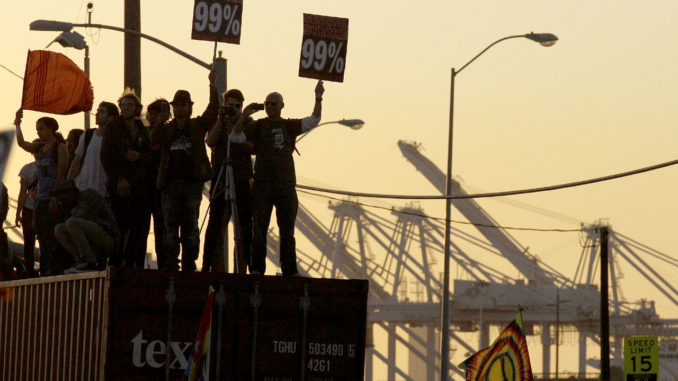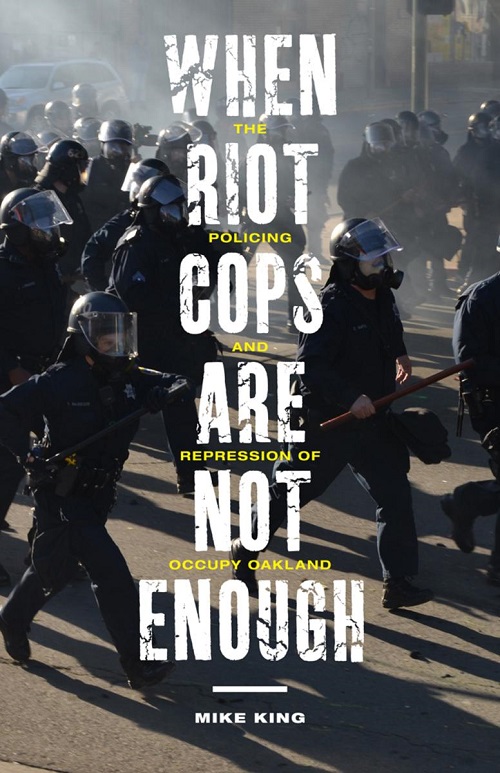
Reviewed: When Riot Cops Are Not Enough: The Policing and Repression of Occupy Oakland, by Mike King. Rutgers University Press, 2017.
In the fall of 2011, a few hundred activists established a protest camp near the Wall Street financial district. Dozens of similar camps soon appeared throughout the country. They stood as a visible symbol of widespread dissatisfaction with the nation’s economic policies; they served free food and met some of the basic needs of the people staying there; and they mobilized large and sometimes boisterous demonstrations, occasionally leading to clashes with police. For many people, the Occupy movement was an initiation into radical politics, an experiment in decentralized and nonhierarchical movement-building, and a glimpse at the possibility for a new kind of society. Yet the whole thing was over in just a few weeks — a crisis quieted, a moment of hope extinguished.
How did that happen?
In his book When Riot Cops are Not Enough, sociologist Mike King tries to answer that question, treating one of the most militant and long-lived camps, that of Occupy Oakland, as a case study.
As the title suggests, police repression is part of the story — but only one part. The Occupy encampments were subject to continuous surveillance, periodic harassment, and occasional violence. Yet the effect of these tough tactics was not what the people with power desired. Police violence pushed Occupy Wall Street into the headlines, it spread the Occupy model, it sparked a national debate about economic inequality, and it shifted public sympathy toward the protest movement. Yet a few weeks later, similar tactics would be employed in nationally – coordinated raids, permanently closing down the camps and producing relatively little public outcry.
 King argues that repression succeeds best when it can present itself as something other than repression. Thus, the police, political leaders, the news media, and even the institutionalized left all engaged in a concerted effort to shape public perceptions of the Occupy movement, its tactics, its relationship to the government, and ultimately its character as “criminal” rather than “political.” The police actions could then be read as “law enforcement” rather than “repression.” In other words, the Occupy movement had to be defeated politically before it could be defeated militarily. King’s account of the conflict therefore stresses questions of legitimacy rather than legality. He does not simply insist that this struggle over public support is important, but examines how legitimacy is constructed and subtly argues that the criteria by which it is gauged are themselves likewise constructed, and that the ability to set that criteria constitutes an important exercise of political power.
King argues that repression succeeds best when it can present itself as something other than repression. Thus, the police, political leaders, the news media, and even the institutionalized left all engaged in a concerted effort to shape public perceptions of the Occupy movement, its tactics, its relationship to the government, and ultimately its character as “criminal” rather than “political.” The police actions could then be read as “law enforcement” rather than “repression.” In other words, the Occupy movement had to be defeated politically before it could be defeated militarily. King’s account of the conflict therefore stresses questions of legitimacy rather than legality. He does not simply insist that this struggle over public support is important, but examines how legitimacy is constructed and subtly argues that the criteria by which it is gauged are themselves likewise constructed, and that the ability to set that criteria constitutes an important exercise of political power.
Ultimately legitimacy comes down to the question of what the larger public is willing to support, or at least put up with. However, the public’s expectations, interpretations, and standards are, to a very large extent, established and structured by the major institutions of the existing society (a position of power that Gramsci called hegemony). Opposition movements make gains when they are able to achieve that same sort of defining position — when the movement’s values inform the moral attitudes of the population, when the movement’s assumptions becomes a new common sense. King writes:
Intrinsic to the process of substantial social change is a shift in what is seen as right, and who has the right to act and exert power in the social world. Part of the process of social movements and social change entails redefining roles and relationship[s] — reconceptualizations of power that are inherently a redefinition of right and wrong. . . . The public’s choice to support the goals and ambitions of the police, city administrators, or the press — or to side with the movement — is an often unstated but essential ingredient in the success of either social movements or repression efforts.
In short, political movements depend on popular support, and to win that support they need to popularize their positions. King therefore argues that movements have to set their own terms, and redefine what is allowable — first, in their own judgment, but eventually in the public mind as well.
King’s account is well documented and his argument compelling. But even his broad approach is, in some respects, still too narrow. First, his account of the contest between the police and Occupy Oakland somewhat inexplicably leaves out the fact that the cops started with a crippling legitimacy deficit, the legacy of the then-recent murder of an unarmed African-American man named Oscar Grant, which resulted in a series of riots. Those events did much to determine Occupy Oakland’s militant and defiant stance toward the police. King seems aware of this fact, but does not explore it. He recounts:
The name of the occupied park in Oakland was immediately changed . . . to Oscar Grant Plaza. . . . An agreement to physically bar police from the camps was passed, and implemented on more than one occasion. A resolution was also passed not to negotiate with city politicians or to grant them a voice within the movement.
These are all important details, but the immediate context driving these decisions, and their resonance with the local community, is not discussed. For this reason, King’s narrative fails to account for the ways that Oakland was exceptional within the Occupy movement, why it became the vanguard camp in terms of militancy and remained among the few stalwarts to continue fighting after the night of evictions.
Secondly, the police strategy King outlines — the emphasis on legitimacy, the shaping of public perceptions of the social movement, the co-optation of nonviolent leaders, and the selective use of violence — has a military name: counterinsurgency. The strategy King painstakingly traces out by inference is clearly explicated in military publications like FM 3-24, the US Army field manual on counterinsurgency, and a growing body of literature relates the military theory and practice of counter-revolutionary warfare to police operations in American cities. Anyone familiar with the military literature will find King’s articulation of police strategies familiar, and even predictable. It is too bad, then, that King neither considers the Oakland Police Department’s approach in terms of the military theory, nor evaluates the military theory according to its successes and shortcomings as applied in Oakland. Each object of study might shed new light on the other, but King leaves this task for future scholars.
And finally, but most seriously, King is probably too generous in his evaluation of Occupy. Though he honestly and directly criticizes specific practices, decisions, and even individual people, there are central questions that he never quite addresses. For example: Isn’t it possible, and even likely, that the police prevailed not because their strategy was so very good, but because the strategy of the Occupy movement was not even bad, but practically nonexistent? Occupy Oakland endorsed definite political positions and cultivated distinctive organizational practices — but it is not clear that it had anything like a unified goal, or agreed-upon priorities, much less a plan for winning whatever it was they were trying to win. Moreover, it may be that its form of organization — self-appointed committees answerable to a continuously-shifting Assembly of whomever happens to show up for the next six-hour consensus-process meeting — could not, on its own, develop, implement, and hold to a coherent strategy. Viewed that way, it is a miracle Occupy lasted as long as it did. If riot cops are not enough to defeat a movement, good intentions are also not enough to sustain one.
When Riot Cops Are Not Enough is an excellent addition to the growing body of literature centered on case studies of political repression and social movement responses. (Kris Hermes’ Crashing the Party is another recent example.) The very existence of these studies is a hopeful sign. They represent an attempt by social movement actors to critically evaluate common practices, to understand the factors that lead to failure or success, and to draw lessons that may help build stronger movements in the years ahead. Such studies do not necessarily lead to better outcomes, of course. But a movement that fails to reflect and reassess will only grow easier to defeat.
The Occupy movement is more than five years in the past, and its legacy is mainly one of frustration. Many of those who participated in the movement soon left, feeling burned-out and disillusioned; others remained despite their own exhaustion and disaffection. But there is still much to be gained from those few tense weeks, if we treat the experience neither as a tragedy nor as a farce, but as an experiment. The lessons of our most bitter defeats may yet supply the seeds of future victories.
Kristian Williams is the author of Our Enemies in Blue: Police and Power in America, Between the Bullet and the Lie: Essays on Orwell, and the forthcoming pamphlet, Whither Anarchism? He is one of the editors of Life During Wartime: Resisting Counterinsurgency.
